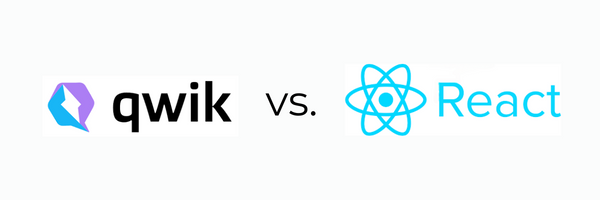
It seems nowadays, there are new front-end frameworks being released each day. However, Qwik.js is the one that truly stands out - with its lightning-fast performance, streamlined architecture, and intuitive coding experience, it's the game-changer your web development workflow has been craving! Its creator, Misko Hevery, is the genius behind one of the top front-end frameworks, Angular. So you know there is a lot of thought and brilliance behind this.
In this blog post, we’ll discuss what makes Qwik.js such a powerful and exciting new framework with features such as resumability vs. hydration, lazy-loading, and how it compares to React.js. Additionally, we will learn about Qwikify, which is a way to convert React components to Qwik.js components!
Resumability vs. Hydration
First up, let’s talk about resumability and hydration. These are two big words that describe two different ways of handling data on your website. Resumability is like hitting the pause button on your favorite Netflix show and coming back later without missing a beat. It lets your application pause and resume execution as needed, making it a great choice for websites with lots of pages that need to load quickly.
Hydration, on the other hand, is like watering a plant that’s been sitting on a windowsill for a little too long. It brings the server-rendered HTML to life by attaching JavaScript event listeners to it. This process lets client-side JavaScript take over rendering from the server, making it particularly useful for server-rendered applications that need to be interactive on the client.
So which is better? It really depends on your website’s specific needs. If you’re building a website with lots of pages, resumability might be the way to go. But if you’re building a server-rendered application that needs to be interactive on the client, hydration could be the way to go.
Lazy-Loading: A Website’s Best Friend
Next up, let’s talk about lazy-loading. If you’ve ever waited for a website to load for what feels like forever, you know how frustrating it can be. But with lazy-loading, your website can load only the necessary components when they’re needed. This can significantly reduce the initial load time of your website, making it faster and more user-friendly.
Lazy-loading is particularly useful for websites with lots of components or large files. Instead of loading everything at once, lazy-loading lets your website load only what it needs when it needs it. This can make your website feel faster and more responsive, which can help improve user engagement and satisfaction.
Qwik.js vs. React.js: The Ultimate Showdown
Now, let’s talk about the showdown between Qwik.js and React.js. Both are powerful JavaScript libraries that can help you build fast, efficient web applications. But how do they stack up against each other?
First, let’s talk about React.js. React.js is a component-based library that lets you build reusable UI components. It uses a virtual DOM to minimize the number of updates to the actual DOM, which can help improve performance. React.js also offers server-side rendering, which can improve performance and SEO.
Qwik.js, on the other hand, uses a template-based approach to building user interfaces. Templates are pre-compiled and cached, which can help improve performance. Qwik.js also offers features like resumability and lazy-loading, which React.js doesn’t have. And, like React.js, Qwik.js also offers server-side rendering.
So which is better? Again, it really depends on your website’s specific needs. React is well-supported and has a ton of packages and libraries at your disposal. Qwik.js is still in beta, but it has such promise, and I would not be surprised if it comes for React’s throne.
Qwikify: The Magic Wand That Converts React Components to Qwik.js Components
Last but not least, let’s talk about the amazing Qwikify. Qwikify is like having a magic wand that can convert your React components to Qwik.js components. This tool is particularly useful if you are already familiar with React.js and want to try out Qwik.js without having to rewrite all of your components. With Qwikify, you can convert your React components to Qwik.js components in just a few clicks.
What are you waiting for?
Qwik.js is a powerful tool for building fast and efficient web applications. With features like resumability, lazy-loading, and server-side rendering, Qwik.js can help you build applications that are both fast and user-friendly. And if you're already using React.js, don't worry - Qwikify can help you make the transition to Qwik.js in no time. I created a nice Typewriter effect that users can import into their own Qwik apps. Check it out here! So, what are you waiting for? Give Qwik.js a try today!







Comments
Add Comment